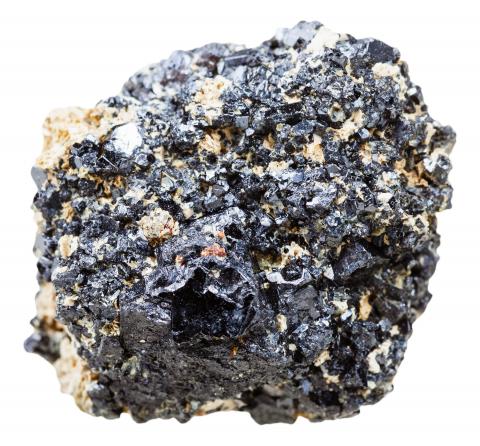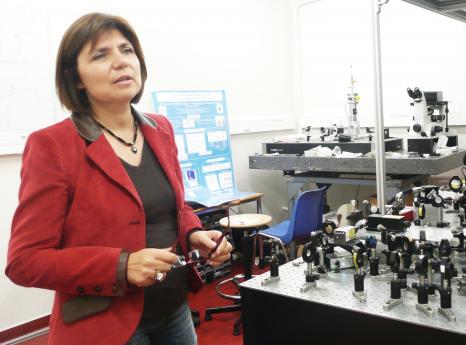
Emmanuelle Deleporte: The photovoltaic revolution
Emmanuelle Deleporte is a university professor at ENS Paris-Saclay and carries out her research at the Lumière, matière et interfaces laboratory (Light, matter and interfaces, LuMIn - Université Paris-Saclay, ENS Paris-Saclay, CentraleSupélec, CNRS). She studies hybrid halide perovskites - molecular crystals with remarkable semiconducting and optical properties. These materials made a stunning entrance into the photovoltaic industry in 2012. However, Emmanuelle Deleporte was not destined to work in this field and her career took a crucial turn...
Hybrid halide perovskites are crystals formed by molecules composed of an organic part and an inorganic part. They have rich optical properties and great flexibility in terms of synthesis and structure. Emmanuelle Deleporte, from LuMIn lab, has been studying them now for nearly twenty years.
An unusual path
A student of the first promotion of ENS Paris born from the merging of the Rue d'Ulm and Sèvres institutions in 1986, Emmanuelle Deleporte specialised in optical properties of inorganic semiconductors. “I studied the confinement effects in inorganic semiconductor heterostructures, i.e. quantum wells or quantum dots, and more precisely excitonic effects, i.e. interactions between electrons and holes (the absence of an electron) and their consequences on the emission properties of these structures.” After her PhD and working as a lecturer at the “Laboratoire de physique de la matière condensée” (Physics and Condensed Matter Laboratory) at ENS Paris, she joined ENS Cachan in 2002 (which became ENS Paris-Saclay in 2020) and the Laboratoire de photonique quantique et moléculaire (Quantum and Molecular Photonics Laboratory, LPQM – Université Paris-Saclay, ENS Paris-Saclay, CentraleSupélec, CNRS). She was director of the Physics Department at ENS Cachan from 2006 to 2016.
Upon her arrival at LPQM, her focus on inorganic semiconductors was at odds with the culture of molecular physics at this laboratory and this forced her to undergo a quick change of direction in her career.
A move towards the organic
To undergo this change, Emmanuelle Deleporte remembered an anecdote from the past which would guide her future scientific choices. “When I started my PhD, my supervisor gave me three samples to begin with. However, the American laboratory which produced them suddenly ceased its activities a few months after I started. It’s a lesson which I always remember and which has guided my professional choices - never depend on anyone for the samples,” says the physicist.
She turned her attention to an emerging subject - photonic cavities. By means of a resonant cavity containing a material, it is possible to couple the quantum state of matter (the exciton) to light (the photons). “In the case of strong coupling, the eigenstates of the photonic cavity and matter are no longer excitons or photonic modes, but a coherent linear combination of a photon mode and an excitonic state called a polariton,” explains Emmanuelle Deleporte. Due to their unique characteristics, these polaritons open the way to new properties, which are useful for lasers, for example. While she was looking for a molecular material with good emission properties, Emmanuelle Deleporte noticed a family of materials, studied at that time by only a few groups in the world, called hybrid halide perovskites.
Initial studies of this material suggested a quantum well electronic structure, similar to that of inorganic semiconductors. Its synthesis did not require complex technology. It relied on a technique called spin-coating, or the centrifugal coating of a precursor solution, which self-assembles into thin films which can be introduced into vertical resonant cavities.
Emmanuelle Deleporte reaffirmed the validity of her new choice. “At that time, perovskites were not very well studied and were not recognised as semiconductor materials. Concentrating on them was a risky move which I could do because I had a permanent job. Starting a new subject is difficult, but after four years of hard work, I was able to publish my first article about my research in 2006.” On the strength of this first result, Emmanuelle Deleporte was able to further develop her projects and then set up an interdisciplinary team, including physicists and chemists, which produces now its own state-of-the-art materials and collaborates with many colleagues from Université Paris-Saclay, in France and abroad.
The photovoltaic revolution
It is now established that perovskites are a new class of semiconductors. They are hybrid in many ways, as they are made up of organic and inorganic materials, and require a combination of concepts from inorganic semiconductors and molecular physics models to understand their physical properties.
In 2012, the Swiss and Korean researchers, Michaël Grätzel and Nam Gyu Park, produced a hybrid perovskite solar cell and achieved an electricity generation efficiency of 9.7% without any particular material optimisation. This was a real bolt from the blue for the photovoltaic industry. Photovoltaic cell efficiency went from 14% in 2013, to 20% in 2016 and then 25.5% in 2020. It was a revolution in the world of photovoltaics. The next step is now to reach an efficiency of 30% with so-called tandem solar cells, which combine perovskite and silicon technologies. The potential of these materials is also increasing in the field of light emission or photodetection.
Federating a new research community
These advances draw on the knowledge of several groups research communities, notably those from the inorganic and organic semiconductors sectors. Since 2017, Emmanuelle Deleporte has brought together this new multidisciplinary collaboration as co-founder and director of the research consortium HPero. Up until June 2020, she was also part of the Strategic Research Initiative MOMENTOM (Molecules and materials for the energy of tomorrow) at Université Paris-Saclay which brought together 26 laboratories and promoted research activities related to current energy issues. This project will soon result in the Institute for Sustainable Energy, which will include the economic and social aspects of this technology.
Today, Emmanuelle Deleporte’s multi-disciplinary team is working on the synthesis of perovskites in several forms (crystals, thin films, nano-objects), the study of their optical properties and their use in photovoltaic or light-emitting components. “In photovoltaics, silicon works very well but the absorption coefficient of perovskites is 100 times greater, i.e. where we need 10 micrometres of silicon in a solar cell, only 100 nanometres of perovskite are needed. This makes solar cells in the form of thin, light films conceivable, which could then be used to cover aircraft or cars, or become integrated into windows. Despite some stability issues which remain to be resolved, hybrid perovskites will find their niche in the commercial world. In the meantime, there are great things ahead of us, especially in terms of discovering new and original fundamental properties,” points out Emmanuelle Deleporte enthusiastically.

